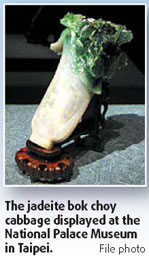
The Forbidden City in Beijing. Quanjing
Visiting the Chinese Palace Museum in one go is no easy task - it will take strong walking legs as well as a plane trip before you can say the job is done. The reason is simple. There are actually two parts to it: the first being the "Palace Museum" in the Forbidden City in the heart of Beijing, and the other being the "National Palace Museum" in Taipei on the island of Taiwan.
The idea of making a one-time tour of the Chinese imperial collections came to me after reading an article in an art magazine suggesting that the two museums should be viewed as a whole in order to have a fuller understanding of imperial history in China over the last 500 years.
To get from one museum to the other is no straightforward matter. The two museums are not affiliated, so there is no such thing as a single ticket covering both visits and until recently, there were no regular direct flights between Taipei and Beijing. Now, if you are lucky, you may be able to buy a much-coveted air ticket on one of the cross-straits weekend charter flights launched this month to get from one city to the other.
I first set out for the Palace Museum in the Forbidden City on a hot summer day, the morning sun already beating hot and intense on the sprawling palace grounds. You will soon discover that the weather plays a big part there as you have to spend more than half the time walking under the open skies from one palace building to another in the vastness of the 720,000 sqm old imperial grounds.

The Forbidden City is in fact the Palace Museum, which was home to the last 24 emperors of imperial China and now makes up the largest and best preserved palace complex in the world. On show are the best examples of Chinese architecture, engineering and traditional artistry.
The Forbidden City was not designed for the 21st century tourist in high-heel shoes; it was designed for foot soldiers and warriors on horseback who lined up in battle formation along broad boulevards for the viewing pleasure of the Emperor .
The 500-year-old Forbidden City must rate as one of the most stupendous relics of history, with more than 800 imperial buildings having been meticulously restored to their former glory. Only about half of these palatial buildings are open to the public, allowing you an insight into the high life led by the descendents on the dragon throne.
Open to the public since 1925, the Palace Museum is first and foremost a museum of the palace buildings and open areas that accommodated the Emperor and his vast number of wives and concubines, courtiers, officials, eunuchs and soldiers. The star of this UNESCO World Heritage Site is really its stunning ancient architecture.
Almost as an after-thought, only a fraction of the 1.5 million imperial art pieces and treasures said to belong to the Palace Museum are on display for public viewing in the main galleries of the Imperial Treasures Gallery, the Stone Drum Museum, the Theater Museum and the Clocks and Watches Gallery.
Is there a better show with the reputedly bigger collection of imperial artifacts at the re-vamped National Palace Museum in Taipei? This was the question that pushed me to plane-hop from Beijing to the island.
In contrast to its counterpart in Beijing, the National Palace Museum itself has less architectural merit, so its star attractions are the many more, and more exquisite, imperial artifacts. They are drawn from its treasure trove of hundreds of thousands of pieces which were spirited away by a defeated Kuomintang army when it escaped to Taiwan nearly 60 years ago just before Mao Zhedong claimed victory at Tian'anmen Square.
These treasures are curated according to themes and historical periods. There are the two famous imperial masterpieces, the jadeite bok choy cabbage and the jadeite belly pork, shown in their full intricately carved glory, which never fail to draw ooohs and aahs from Chinese visitors familiar with their history. There is even a pictorial map of the Forbidden City with markers indicating the exact locations inside the particular palaces where these two stellar pieces and other treasures were originally housed.
While the Taipei collection is impressive, you will likely have the same there-must-be-more-than-this feeling as in Beijing. If the imperial art collection in the hands of the National Palace Museum really numbers 650,000 precious pieces, where are they all?
In retrospect, each of the two Chinese Palace Museums has an incomplete story. The Palace Museum in Beijing is a grand old palace basking in all its architectural wonder but missing its precious contents. The National Palace Museum in Taipei may be known more for the imperial treasures it does not display than those it does.
As a student of Chinese history, I enjoyed the stunning architecture of the imperial palaces in Beijing, while at the same time I appreciated the choicest Chinese imperial treasures displayed in Taipei.